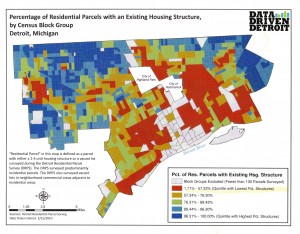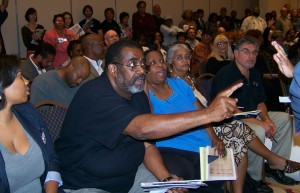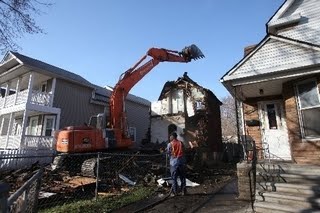Angry residents confront Bing at first community forum
By Diane Bukowski
DETROIT – Over the past month, Mayor Dave Bing has purported to bring a “kinder, gentler” Trail of Tears to Detroit citizens with his Detroit Strategic Framework Plan, otherwise known as “Detroit Works.”
He has said that he will not force residents from their homes in areas of the city his planners claim are sparsely populated, but gently encourage them to leave. He has claimed to listen to the community in a series of five public forums.
“I am not down-sizing Detroit,” Bing told the audience at the first event, held Sept. 14 at Bishop Charles Ellis’ palatial Greater Grace Temple on Seven Mile and Telegraph. “Detroit will still be 139 square miles.”
Bing has said he has no plan himself; that he is waiting for the conclusion of the September forums and future meetings with city administrators to create that plan with Detroiters’ input in mind.
Wanda Hill said she did not believe there is no plan. She called it “disrespectful” for Bing to call the forums when residents don’t know what his “real intentions” are.
A constant refrain throughout that and subsequent forums was that Detroiters don’t want to see the PEOPLE down-sized or moved. Speakers said Detroit should be REBUILT and that the population should be INCREASED.
Toni Griffin, an urban planner imported from Washington, D.C. and paid by the Kresge Foundation to head the Detroit Works project, has been in Detroit since March according to Crain’s Detroit.
She and Karla Winters of the city’s Planning and Development Department introduced themselves at the beginning of the forum, then broke the angry audience of over 1,000 people into five groups using sliding partitions. Group One was facilitated by representatives of the Skillman Foundation and Hamilton Anderson Associates.
Bing popped into Group One for a short time, only to be confronted by Raynard Davis, who stood and pointed his finger angrily at the Mayor.
“Why are you talking about shrinking the city instead of growing the city?” Davis asked. “The infrastructure can be repaired and improved, but the city is holding off. The private corporations and the banks deliberately let the city go, instead of bringing in industry and creating jobs.”
Bing responded nervously, “There are changes happening as we speak. I have already authorized 1800 homes to be torn down.”
According to reports, the demolition of up to 10,000 homes is on the drawing board, with some of the money coming from HUD’s Community Development Block Grant Program and federal recovery funds.
Davis said, “Supposedly there are 85,000 empty houses in Detroit. We need to get them purchased and fix them up so the owners can start paying taxes. When one person sees you fixing up a vacant house, another will follow.”
“People like me won’t be here twenty years from now,” said an 83-year-old woman. “I want to see our schools open again. It hurts my heart to hear all these vacant houses are being torn down. A big church like this could adopt 100 houses and provide places for us to nurture ourselves and our families. People that lost their homes should get them back. Houses are empty, schools are empty. The city can actually bring in more people; give out Section 8, put people in the skilled trades to work fixing them up. Instead, the schools are closing faster and faster and homes are getting burnt up.”
She said Detroit should provide a computer for every household, and wi-fi access for the entire city.
Some speakers touted the use of “green” energy solutions and urban gardening to provide a base for Detroit’s re-development.
But Destiny Johnson said, “It’s hard to be green when you have utility practices like those of DTE, with high bills and constant shut-offs.”
Another speaker condemned DTE for failing to maintain its infrastructure in Detroit, and its refusal to trim vegetation around electrical wires, a deliberate practice that led to fires in 86 homes during a windstorm Sept. 7, according to speakers at a Sept. 25 Michigan Public Services Commission meeting.
Several speakers, including laid-off school workers, condemned the closing of at least one-third of Detroit’s schools over the last five years during the state takeover, under the elected board, and now under the state emergency financial manager Robert Bobb. They tied those closings to the loss of housing stock due to foreclosures and evictions.
A flier distributed at the forums by D’Artagan Collier, Socialist Equality Party candidate for the state legislature, echoed the concerns of many residents (excerpts below):
“I reject this plan, which will further devastate the lives of working people and the unemployed, Collier said. “Instead of shrinking the city, I call for a massive expansion of public services—education, housing, health care and recreation—and the establishment of a public works program to hire the unemployed at good wages to rebuild the city.
“Mayor Bing speaks for the business elite, not the people of Detroit,” Collier continued. “He served for 20 years on the board of directors of DTE Energy, which wants to drastically shrink the area in which it must provide utility services to the poor, because these services generate little profit. The claim that shrinking the city is a necessary response to a declining population is a self-serving lie. The population loss is the result of the decades-long attack on the working class and the destruction of jobs, living standards, education and other services. The further dismantling of the city will not lead to “stronger neighborhoods,” but will drive out ever larger segments of the population.
“The downsizing policy is also based on the lie that there is “no money” for maintaining, let alone expanding, social services. This comes after trillions of dollars have been handed out to the banks and spent on wars abroad.”.

Red areas on "Data Driven Detroit" map allegedly have 0 to 57 percent occupancy, will be likely targets of Bing plan
It was clear at the meetings that the “kinder gentler” rhetoric Bing has been spouting is nothing more than a warmed-over version of his original plans, announced in March. The same maps from Data Driven Detroit which Bing published in March were distributed. The maps delineate the areas of the city that are subject to be targeted in the coming years. (See population map.)
For more on this attack on targeted neighborhoods, see this author’s article “Bye Bye Detroit,” (generally referred to as The Trial of Tears in national media), which described the purpose of these maps. It is available at http://michigancitizen.com/bye-bye-detroit-p8374-1.htm.









Can we solve the previously unsolved problems, and reverse the acceleration towards unworkability by merely choosing to adopt oppositional viewpoints? If we keep acting as if the only choise is which side of the same coin is best, we remain blinded to transformation and settle for change (and, the more things change, the more they stay the same). To paraphrase things, Einstein said that people cannot solve problems using the same paradigm of thinking that allowed the problem to occur in. Who’s right?- Who’s wrong? Is that a question worth asking and a question that will open up possibilities for seeing what needs to be seen to accomplish the heretofore unaccomplishable?
The integrity of our leadership and our complacency about being resigned to things “just being the way they are and always have been” both might be warant some review and renewed spirit?
Maybe the question of who’s right or who’s wrong might be displaced by first getting in phase and harmony — communicating to create a shared vision of what is possible and see what shows up as possible and worth doing from that point of view. If our leaders cannot create that discourse, then, who will?
I support the premise which seeks to grow the city instead of surrender, retreat, downsize, reduce, the city. A land bank can be a vehicle to utilize the full potential of all of the land use issues in the city…
I would be leery of who controls the land bank. Under state law which established the Michigan Fast-Track Land Bank Authority, both Detroit and Wayne County have set up their own land banks. The problem is that the land which is banked was frequently taken through foreclosures and other actions that may not have been legal. The original owners may have a right to return, as people in New Orleans demanded the right to return. Land banks are often set up tp bypass strict oversight of ownership rights. But I certainly support the essence of your comment regarding growing Detroit. When did it become the appropriate attitude that Detroit was doomed to be forever downsized? When it became a majority Black? When the auto industry left? There has been no leadership that has taken the reins and looked for ways to bring new jobs for the people who are here, and provide a new economic base that will attract others back to the city. Detroit has a PROUD history: it helped birth the union movement, the civil rights movement, the revolutionary Black nationalist movement including the Nation of Islam. It is not a city in RUINS as outsiders love to portray it–there are wonderful, vibrant, loving and caring people here who deserve the opportunity to have a future for themselves, their children and their grandchildren.
Great societal shifts and gigantic shifts regarding future possibilities for people have been championed by people with bonds to Detroit and the Detroit area. Steve Balmer, Henry Ford, Joe Louis, Hoffa, Ruther, Kresgee, Buroughs, Rosa Parks, Malcom X, Iacoca come to my mind immediately.
Downsize vs. upsize? Do more, better? How about first examining who we are and what we stand for, then after having creating a context and orientation, we might be to powerfully create/identify opportunities that would fulfil on THAT– then identify/create actions that would forward the accomplishment of the opportunities on behalf of accomplishing the possibility that the context gives us a glimpse of. Maybe the same actions coming from and being managed from a different point of view could yeild more effective results? If we don’t know where we are AND where we want to get, how do we know what direction to go, or what sort of propulsion method would get us there?
Yet, we